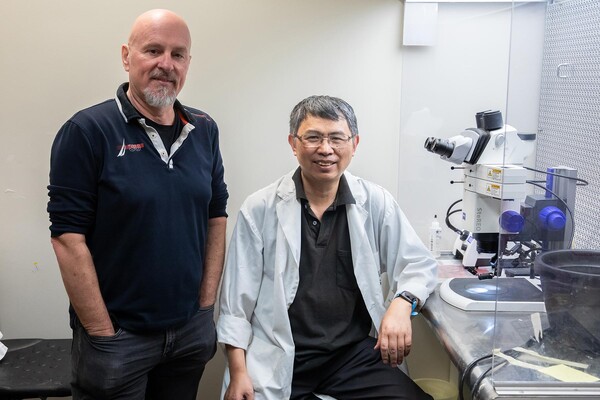Main Second Level Navigation
Breadcrumbs
- Home
- News & Events
- Recent News
- World AIDS Day: New treatment strategies and support for older adults with HIV
World AIDS Day: New treatment strategies and support for older adults with HIV

Over four decades after the start of the AIDS epidemic, researchers in the Emerging and Pandemic Infections Consortium are reshaping approaches to target the human immunodeficiency virus (HIV) that causes AIDS and to care for people with HIV.
Current HIV treatments work by blocking different stages of the virus’ life cycle. By suppressing viral load, the drugs prevent the development of AIDS and reduce the risk of transmission. However, these therapies are not curative and over time, the risk of drug resistance increases.
“Most of the current antivirals are ‘one drug, one bug’ therapies that target a specific viral protein,” says Subha Dahal, a recent PhD graduate who completed her doctoral research in Alan Cochrane’s lab in the department of molecular genetics at the University of Toronto’s Temerty Faculty of Medicine.
One limitation of a “one drug, one bug” approach, Dahal explains, is that it requires the development of many different treatments to confront the equally vast number of infectious threats that we face. Drugs that target the pathogen are also more likely to lose their effectiveness as the microbes develop resistance to the treatments. This is a particular challenge with HIV because the virus has a very high mutation rate that allows it to change rapidly.
“Many viruses rely on the similar host processes. If we can target those host pathways, then we could hit multiple bugs with one drug,” says Dahal.
Driven by the goal of developing broad-spectrum antivirals that would work against HIV and other viruses, Dahal and her colleagues tested dozens of compounds from compound libraries to identify ones that showed promise.
In a study published recently in the Journal of Virology, the researchers describe the effects of a plant-derived compound called harmine. They discovered that harmine effectively blocks HIV replication by disrupting host machinery that the virus relies on. The researchers also showed that at the levels needed to stop HIV replication, harmine caused limited changes in the host cell, suggesting that the compound may have fewer harmful side effects.
When the COVID-19 pandemic underscored the urgency of finding new coronavirus inhibitors, Dahal and her colleagues made a strategic shift in their work to investigate whether their HIV-blocking compounds could also combat coronaviruses. Coronaviruses are unrelated to HIV but use some of the same host pathways to replicate inside our cells.
They went back to their compound libraries and found that harmine was also effective in blocking a seasonal human coronavirus, which causes the common cold, and several variants of SARS-CoV-2.
This study, much of which was done in the Toronto High Containment Facility, provides evidence for a “one drug, many bugs” strategy. Harmine’s success in inhibiting both HIV and coronaviruses, despite the substantial differences between them, also highlights its potential for antiviral drug development.
Dahal notes that a phase one clinical trial is underway to evaluate the safety of harmine during treatment of diabetes. “If that trial succeeds, then I think harmine has potential to come to humans.” In the meantime, she would like to test harmine’s effectiveness in animal models of SARS-CoV-2 infection and delve deeper into the biology of how the small molecule counteracts viruses.
The innovative work of researchers like Dahal have led to life-saving therapies that changed HIV from a fatal infection to a chronic condition that can be managed with medications.
“For a long time, being diagnosed with HIV was really a death sentence because we had no effective treatments,” says Alice Zhabokritsky, a clinician investigator in the division of infectious diseases at University Health Network.
“As treatments became more effective and tolerable, people started to live longer. Now we’re at this interesting time point where we’re seeing a large number of individuals over the age of 65 who have aged with HIV from the early 1980s.”
Zhabokritsky is one of the researchers working with the national CHANGE HIV Study, a five-year cohort study that aims to improve our understanding of the complexities of HIV and aging. The study is led by Sharon Walmsley, director of the Immunodeficiency Clinic at University Health Network and a professor of medicine at U of T. As the first geriatric HIV cohort in Canada, it includes individuals who are considered long-term survivors with HIV as well as older adults who were more recently diagnosed. Zhabokritsky notes about one in five new HIV diagnoses in Canada are among people over the age of 50.
First launched in 2019, the study has already enrolled over 450 individuals and will follow participants over time to track physical, mental, cognitive and social aspects of health.
“We’ve taken a very broad approach to what health means,” says Zhabokritsky, who is also an assistant professor of medicine at U of T. “In additional to the typical things people think about like the presence of medical conditions, we’re also trying to capture the psychosocial experience of aging like feelings of loneliness, isolation and stigma. These all impact an individual’s quality of life as they get older.”
The data will help researchers identify differences between people who are thriving and those who are struggling, and point the way towards new strategies to better support those aging with HIV.
One of the trends already observed from the CHANGE HIV Study and other geriatric HIV cohorts around the world is that the conditions typically associated with aging — like diabetes and cardiovascular disease — tend to occur more frequently and much earlier in people with HIV.
Zhabokritsky and her team are also working closely with a community advisory board made up of people living with HIV to ensure that the study is answering questions that are relevant for them. As data comes in, the researchers plan to share it with their patient partners to determine which areas of health should be prioritized for future work.
“I hope we can start closing the gap in health outcomes between the general population and those living with HIV. We’ve done so well in terms of extending the life span, but our patients are still impacted to such a great degree. As they’re aging, we want to make sure that they’re not just living, but that they’re living well.”
News


